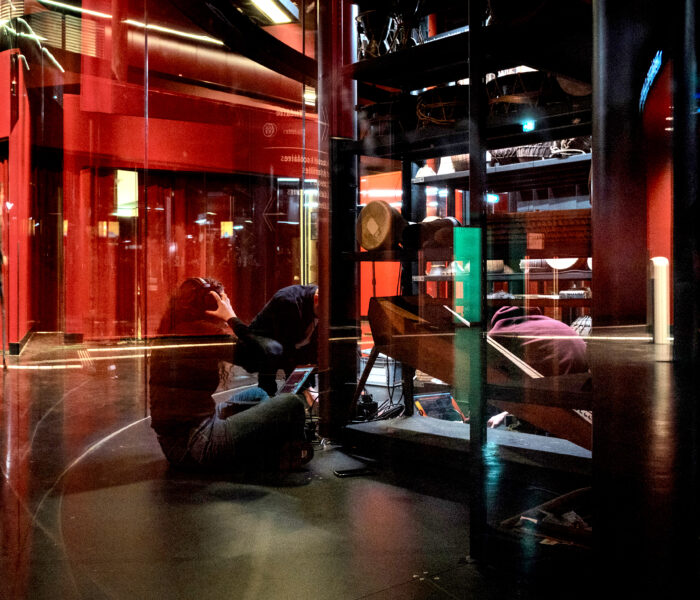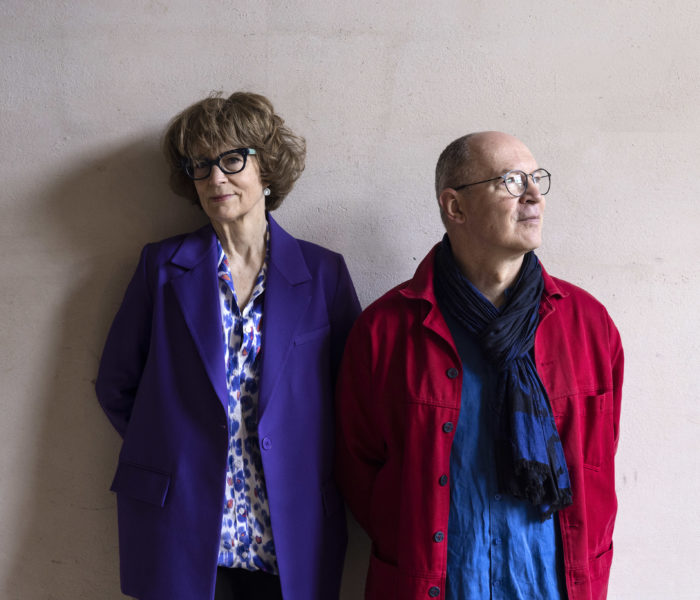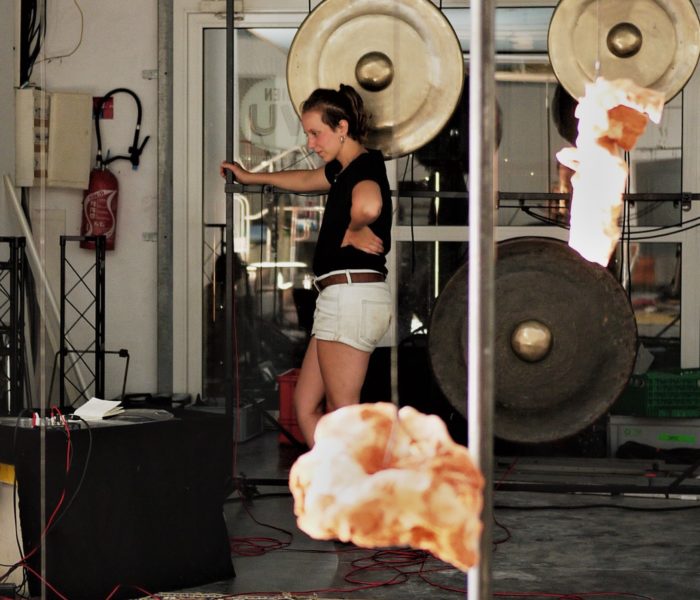La bassiste et compositrice Floy Krouchi vient du monde du rock et de la tekno libre, celle qu’on écrit avec un « k », dont elle a écumé les free parties et les teknivals durant les années 90 avec son groupe de dub électro Mafucage. Au début des années 2000, elle suit une double formation qui remodèle en profondeur sa pratique : en électroacoustique, dans un conservatoire parisien ; et en musique indienne, auprès d’un maître de rudra veena, Pandit Hindraj Divekar, à Pune. Elle relie aujourd’hui ces deux enseignements au cœur de son projet de basse augmentée, la FKBass.
Tu es bassiste. Comment et quand as-tu choisi cet instrument, lié a priori au monde du rock et des musiques pop?
J’ai commencé en autodidacte. La basse est un instrument qui se joue beaucoup dans les groupes qu’on monte comme ça, entre amis. Elle m’a attiré parce que j’étais marquée par deux influences : celle des musiques électrifiées (la pop en général) et celle du reggae/dub, et plus particulièrement du dub, qui m’intéressait depuis mon adolescence. J’ai trouvé dans cette musique à la fois la présence de la basse, qui reste un élément prégnant, et tout ce qui concerne la manipulation sonore.
Tu penses au dub jamaïcain, ou à ce qu’a pu en faire ensuite un groupe comme Massive Attack?
Je pense aux deux, le dub jamaïcain, et bien sûr Massive Attack un peu plus tard, qui a contribué à tout mélanger avec succès : le son électrique, électronique et urbain avec les techniques et la vibe du dub. Dans les années quatre-vingt, j’écoutais tous les labels jamaïcains et anglais consacrés, les 45 tours de Studio one notamment, le label On-U Sound d’Adrian Sherwood, avec le groupe African Head Charge. Ça m’a beaucoup influencé. J’ai cependant toujours mené en parallèle mon parcours de recherche avec mon parcours de musicienne. J’ai appris l’harmonie au conservatoire, j’ai fait du jazz et du free jazz, en même temps que je jouais dans des groupes. J’avais intégré cet esprit expérimental depuis la fin des années quatre-vingt : je travaillais chez moi sur des manipulations de cassettes, walkmans, radios, volume sonore… J’avais déjà expérimenté toutes les bases schaefferiennes en bricolant sur du petit matériel, de manière ludique. J’ai conservé un stock de cassettes de toute cette époque.
Tu participes à un collectif féminin de musique expérimentale dans les années quatre-vingt-dix, Mafucage, dont tu dis qu’il était en phase avec les musiques électroniques en pleine effervescence lors de cette décennie. Peux-tu m’en dire plus?
J’ai co-fondé avec Mxr Koznen 1994 mon premier groupe important, Mafucage, qui réunissait toutes ces influences. Nous étions deux à la base (basse-guitare), rejointes ensuite par une batteuse Krx Prince. L’idée était celle d’un groupe instrumental : j’ai toujours aimé le fait qu’il n’y ait pas nécessairement de chant et de paroles, et simplement travailler avec le son. Nous avons sorti des vinyles et pas mal joué en free party à la fin des années quatre-vingt-dix. J’aime les morceaux de cette époque, dans un style dub indus, je trouve qu’ils n’ont pas vieilli. Mafucage a constitué ma première grande expérience professionnelle : nous avons tourné beaucoup, nous avons produit nos disques nous-mêmes dans un cadre Do It Yourself (DIY). C’étaient de belles années, à Paris. Je n’ai jamais été une teufeuse invétérée, j’ai de toute manière toujours été plutôt en périphérie dans mon parcours. Ce qui m’intéressait surtout était ce qui se produisait dans le cadre particulier de la free party. C’était un mouvement magnifique : les possibilités d’expérimenter le son dehors, dans des contextes bien distincts des salles officielles, à fort volume.

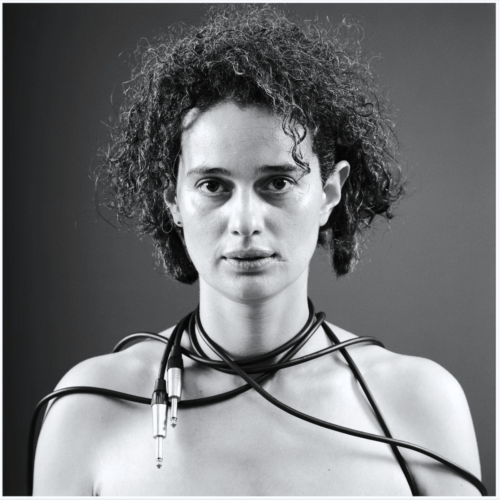
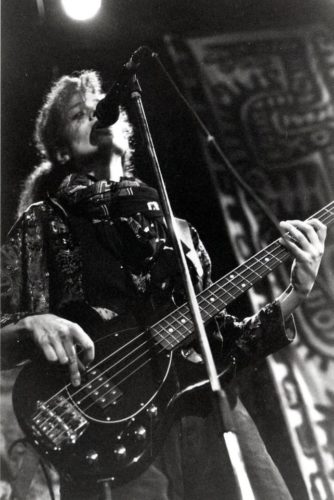
J’ai bien connu cet univers de la free party dans les mêmes années. Mafucage était-il rattaché à un sound-system en particulier?
Nous étions distribués par Toolbox. Nous avons produit notre premier vinyle à Grenoble avec CORE-TEX labs. Comme nous étions downtempo, nous jouions dans les teknivals plutôt au petit matin, en after. Nous n’étions pas affiliés à un sound-system en particulier, mais nous avons souvent joué avec les Anglais d’Hekate : un superbe sound-system, pour la vibe, la qualité du son, la tendance expérimentale. Nous nous produisions également sur des scènes plus officielles durant la période, des grosses salles, des festivals. J’ai participé à un défi jeune à l’époque : un dispositif pour monter un studio d’expérimentation, que j’ai obtenu, et j’ai pu m’équiper en enceintes, table de mixage, sampler Akai MPC 60. J’ai bien approfondi l’univers du sampler, du remix et de la manipulation sonore. On jouait aussi parfois tout simplement le trio basse-guitare-batterie en invitant des performeuses, des poètes… C’était un beau collectif, car nous avons beaucoup ouvert les formes. Le champ d’expérimentation sonore et humain m’a toujours plus intéressée que le format groupe, même s’il est également beau en soi. Cette période a duré de 1997 à 2003. J’ai également participé au collectif Planet Generation Global Move pour quelques vinyles.
Tu étudies ensuite la musique électroacoustique au conservatoire à Paris, au début des années 2000, ce qui te permet de travailler sur la « musicalité des sons enregistrés ». Qu’est-ce qui te pousse dans cette voie plus « académique », et un peu plus tardivement?
Après cette période de neuf ans avec Mafucage, j’ai eu envie d’approfondir, de savoir d’où venaient les origines de notre travail, et de me tourner vers une connaissance plus « savante » de la pratique sonore depuis Schaeffer, même s’il y avait eu d’autres expériences déjà avant lui. Je voulais aller plus loin sur la manipulation du son enregistré. J’ai trouvé mon bonheur dans la classe de Gino Favotti au conservatoire du 20e arrondissement de Paris. C’était une classe très libre qui me correspondait bien. Elle était fréquentée par des réalisateurs, des poètes, des électro-acousticiens : des parcours variés qui offraientt un véritable lieu d’échange artistique. Nous jouions nos pièces dans un acousmonium, ce qui était un moment savoureux. Cet orchestre de haut-parleurs m’a fasciné par sa beauté, bien supérieure à celle de la simple multiphonie. Il s’agit d’un véritable instrument. J’ai lâché la basse à cette période. Je fréquentais la classe en tant que manipulatrice de son, dans le but d’augmenter mon vocabulaire au niveau de la composition sonore. Comme tout groupe de rock, Mafucage a clashé. J’avais beaucoup donné, j’ai eu besoin de faire autre chose, dans le domaine du son pur. J’ai reçu une commande du GRM (Groupe de Recherches Musicales) . Ça m’a permis de sortir de la scène alternative purement underground pour pénétrer un monde plus académique, même s’il ne l’est pas complètement. Tant que l’expression artistique est intéressante, je suis prête à expérimenter différents milieux. Il est certain que celui de l’électroacoustique, qui est une branche de la musique contemporaine, est tout de même très différent du monde de la free party. Cependant, je considère que la musique pop est également un lieu qui favorise énormément d’inventions sonores, technologiques, techniques, et je ne souhaite pas séparer ces univers.
Aujourd’hui, les frontières sont beaucoup plus perméables, et tu en es une preuve vivante par ton parcours.
Tout à fait. Ce qui m’intéresse, c’est la traversée. La différence avec monde de la pop et de la folk en général (j’inclue les musique traditionnelles) est qu’on n’y écrit pas ou très peu et qu’on ne travaille pas avec des partitions. C’est sur ce point que s’effectuent les chocs entre ces mondes. l’écriture versus l’oralité. Mais un grand nombre de compositeurs et de compositrices, dont je suis, ouvrent des voies d’écriture entre improvisation et notation.
Ce moment correspond également au début de tes voyages en Inde, où tu te rends régulièrement depuis 2003 pour y étudier la musique traditionnelle hindoustani et l’art des ragas. Pourquoi cet intérêt pour ce pays et pour cette musique en particulier?
J’y suis allée avec le collectif Planet Generation Global Move à l’an 2000, pour y jouer un live électro entre Goa et Bombay. On nous a parlé du maître Pandit Hindraj Divekar à Pune, qui jouait d’un instrument à quatre cordes, la rudra veena, qui ressemble beaucoup à la basse. Nous sommes partis à sa rencontre et j’ai flashé complètement sur l’instrument. Après une série d’enregistrements, j’ai mûri cette découverte. Trois ans plus tard, quand Mafucage s’est séparé, j’ai ressenti le besoin de le retrouver. Un cycle s’achève et la vie a besoin de recharges, d’un nouveau souffle, que j’ai trouvé à la fois dans la classe d’électroacoustique et dans une nouvelle pratique instrumentale inspirée par l’Inde, poussée à son extrême lenteur. Je m’y suis rendue avec une basse fretless Fender Precision, car j’avais changé d’instrument entre-temps. Je découvrais alors de nouvelles possibilités concernant la microtonalité et les glissandos. La rudra veena est l’ancêtre de la basse, avec ses quatre cordes. Elle est considérée comme l’instrument le plus ancien et le plus sacré de la musique indienne. C’est l’instrument des méditateurs. Elle possède une résonance extrême de dix-sept secondes. Il se passe énormément de choses à l’intérieur d’une note : notes de passage, effets de filtrage, de hauteur, tout cela au cœur de la résonance, sans nouvelle attaque du son. Ses fréquences basses sont très intéressantes, amplifiées par deux gros résonateurs qui consistent en deux citrouilles séchées. L’oreille est collée à l’instrument et capte uniquement du bas et du rond qui tourne, qui passe par le manche et revient d’un résonateur à l’autre, sur le principe d’un mouvement infini, en forme de 8.
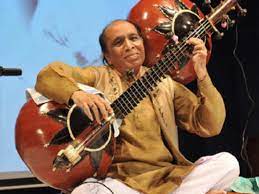

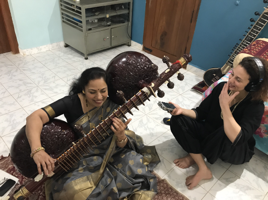
Et tout cela s’opère, je crois, à un volume très faible. C’est vraiment l’instrumentiste qui reçoit le plus les effets sonores.
Absolument. Au cours de mon travail avec Pandit, je l’ai sonorisé, car je ne l’entendais pas assez. Je l’ai équipé d’un micro pick-up comme pour une basse, avec un amplificateur. On raconte qu’on jouait de cet instrument de méditation dans les caves et les grottes, des atmosphères naturellement résonantes, au temps où le silence était très grand. Ce faible volume explique pourquoi il était en train de disparaître. Il connaît aujourd’hui un regain d’intérêt. C’est un instrument auquel on attribue des propriétés magiques, un instrument de yogi, qui accompagne avant tout la méditation du musicien lui-même. On raconte qu’il a été directement offert par Shiva aux Hommes, et qu’il possède les formes de Parvati, qui représente le concept de la mise en énergie. Il a changé de fonction en se retrouvant dans les palais, où il accompagnait le dhrupad, la forme la plus ancienne du chant indien. Les cordes tirées de la rudra veena sont en effet très proches de la corde vocale. Ses propriétés sonores sont incroyables ! Ce n’est pas un instrument virtuose et éclatant comme le sitar. Il ne fait pas beaucoup de notes mais c’est à l’intérieur qu’il se passe des choses très intéressantes. Je n’ai pas appris la rudra veena. Je m’asseyais face à Pandit avec ma basse et j’apprenais les ragas à l’indienne. J’ai tenu à garder mon propre instrument. Ce n’était pas mon chemin, j’avais déjà la trentaine et je préférais travailler sur la rencontre entre ces deux instruments plutôt que d’en apprendre un nouveau.
C’est donc cette rencontre qui te donne l’idée d’un solo de basse?
Il y a deux choses qui sont entrées en jeu : d’abord constater que la basse est un très bel instrument mélodique, et tout particulièrement la fretless ; puis l’idée de l’hologramme à l’écoute de la rudra veena, cette richesse incroyable à l’intérieur du son qui semble reconstituer l’oreille, amener une présence, donner à entendre quelque chose d’inouï, mais qui n’est pas là. J’ai fait le lien avec la question des sons inouïs de l’électroacoustique. Ça a pris du temps, j’ai réalisé beaucoup de pièces radiophoniques dans la période et mené d’autres projets. J’en suis arrivé à cette idée du solo de basse augmentée, l’électronique permettant de me sortir du spectre assez réduit de la basse et de l’ouvrir vers le bas et vers le haut. Pour moi, la pratique instrumentale permet la richesse de la nuance, et la pratique électroacoustique la richesse du spectre. L’idée était d’associer les deux.
Tu dis que cette découverte t’a amené une nouvelle appréhension de la musique, des nouveaux processus d’écriture et une manière de te plonger au cœur du son pour le faire évoluer. Peux-tu l’expliquer plus en détail?
Il y a d’abord la question de l’écoute extrêmement précise de l’intérieur du son, qui rejoint d’ailleurs celle que l’on expérimente en électroacoustique. On se concentre sur la micro-tonalité. Les échelles indiennes reposent sur vingt-deux micro-tons (shrutis). Il y en a plus dans la réalité, avec les notes de passage et la manière de jouer certaines notes dans certains modes, par-dessus ou par-dessous. En Inde, on considère que le son a créé l’univers, au travers de la vibration primordiale du om. On dit que les sages entendent tous les sons. Dans les faits, on sait scientifiquement que tout est effectivement vibration, et cette question est devenue cruciale pour moi, au centre de ma réflexion. Cette dimension spirituelle que m’amène l’Inde poétise un phénomène physique que nous connaissons bien en Occident. J’aime à penser les liens entre ces mythes et les théories scientifiques qui mesurent la résonance du son du big bang. L’autre apport est celui des ragas. Le raga se rapproche beaucoup du jazz modal, que j’avais pratiqué. On y trouve un dialogue entre formes fixes et totale improvisation. Et puis les ragas sont liés à la nature, au cycle des saisons, au cycle du jour. Tout est lié en Inde, la nourriture, les instruments… Par exemple, le drone de la tanpura va évoluer au fil du jour. Le musicien accorde son instrument au lever du jour. Puis la température change, et le deuxième raga est légèrement en dessous. De la même manière, en électroacoustique, nous prenons conscience de la résonance d’un espace. Rien n’est un phénomène isolé. Toutes ces choses nourrissent ma musique, elles m’habitent.
Tu me dis que tout cela a pris du temps de maturation. De quand date ton premier solo de basse?
J’ai réalisé des solos avec des pédales d’effets pendant toute la période, mais mon premier Bass Holograms avec une basse augmentée date de 2012, sur une commande du CNCM Césaré à Reims, avec une basse Westone, caractérisée par un très long sustain et des micros actifs qui permettent d’aller dans le très grave et le très aigu. Il y avait trois couches : le jeu instrumental ; l’électricité et les micros ; et la lutherie virtuelle. Césaré est co-producteur du nouveau projet de FKBass, débuté en 2017, qui ajoute le niveau du contrôle de l’électronique, via les capteurs.
La FKBass est en effet équipée de plus d’une quarantaine de contrôleurs assignables pilotés par un microprocesseur interne, certains tactiles, d’autres sous forme de capteur.
Oui, des capteurs ultra-son, un gyroscope et un accéléromètre sur la tête, des écrans, le lighthouse… C’est une des grandes questions de la musique contemporaine : comment faire vivre l’électronique autant que le jeu instrumental, et de manière aussi fine que l’on peut contrôler un instrument par le geste.
Chaque contrôleur est assignable. Changes-tu les assignations en fonction des morceaux ou restes-tu sur un système que tu maîtrises pour tous?
La FKBass a été achevée à la fin de 2018. Jusqu’à maintenant, j’étais en étude, notamment en Inde. J’ai essayé beaucoup de configurations pour des mouvements différents. Sur le premier solo que je vais écrire, je vais me construire un instrument un peu plus fixe et m’imposer certaines limitations, pour pouvoir rentrer dans la finesse du jeu des capteurs. Il est possible que je me permette deux ou trois états de configuration différents selon les mouvements, mais je vais essayer d’écrire quelque chose de transmissible, clair et sans trop de changements.
Quand on observe un groupe de pop, on voit le batteur, le bassiste, le guitariste avec toutes ses pédales, ce qui est encore gérable au niveau du son, mais le clavier a toujours besoin de ses notes pour s’y retrouver sur son synthétiseur, pour fixer sa mémoire et retrouver ses sons. Il y a un paradoxe entre la richesse immense de ses timbres, qui semble ouvrir à une certaine liberté, et la contrainte de devoir les retrouver pour les exploiter ; entre l’aspect direct du jeu, sensitif et organique, et le frein de la technologie.
C’est un des plus gros challenges. Avec des instruments comme la FKBass, la palette sonore est gigantesque, on ouvre des mondes. C’est un grand pari de pouvoir lâcher complètement l’ordinateur. Je n’en suis pas encore là. Nous n’en sommes qu’aux balbutiements des instruments augmentés. Je ne devrais pas avoir à regarder un ordinateur. Le jour où on pourra jouer une composition complète, un vrai solo d’une heure, sans sortir de son jeu pour regarder l’écran et y effectuer des réglages, les choses auront bien avancé. C’est pour cette raison que j’ai mis autant de capteurs sur la FKBass. C’est un pari, mais c’est un long processus.
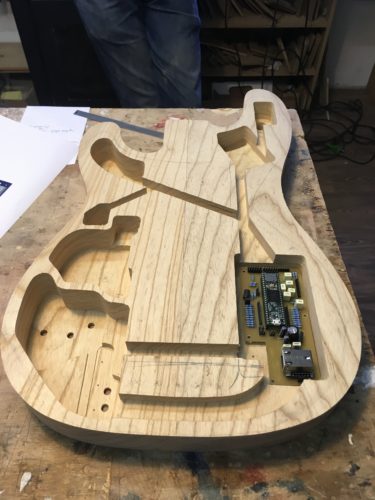
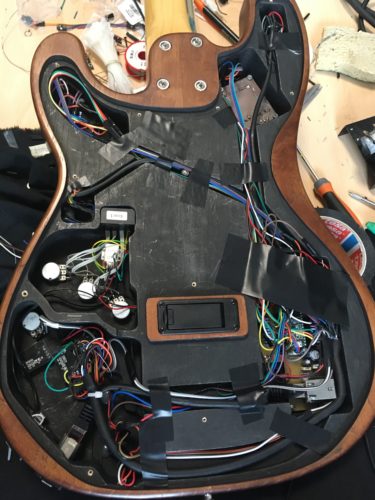
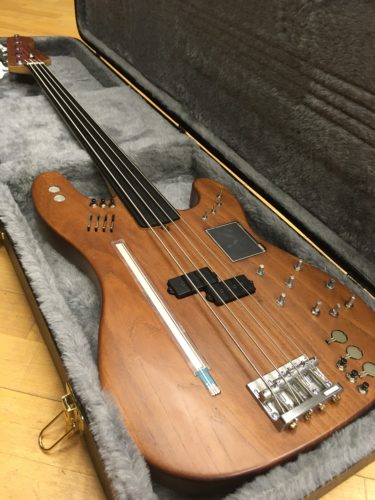
C’est le paradoxe d’un contrôleur : un potentiomètre, une surface de contrôle ou un interrupteur ne donnent pas une idée précise du son que l’on va obtenir, contrairement à une corde, un archet ou une touche.
Oui, c’est l’apprentissage d’un nouvel instrument. C’est pour ça qu’il faut resserrer les possibilités, tout en conservant la richesse de la palette sonore : il faut apprendre à bien les utiliser, il ne faut pas douter des gestes qu’on est en train de faire, ça doit rester organique.
Cependant, et ça semble constituer une part non négligeable du plaisir que tu y trouves, l’instrument te guide autant que tu le guides, c’est-à-dire que tu as des surprises, et qu’elles te sont assez profitables, dans un rapport ludique.
Bien sûr, c’est parce que j’aime l’improvisation ! Mes formes sont semi-écrites, semi-improvisées. Tout sort de la basse, mais je peux avoir un passage basé sur un looper dont certains paramètres sont aléatoires. Je suis donc obligée d’attendre, d’écouter, de me laisser guider, comme si je jouais avec une autre personne. C’est aussi un aspect qui me vient de l’Inde : quand je joue une note, j’écoute en profondeur ce qui se passe dans l’espace. Cela guide mon jeu. J’ai parfois l’impression d’être capitaine d’un grand navire, il faut que je joue avec la latence, avec les mouvements.
Ce dépassement par l’instrument et ses sons est quelque chose que j’ai souvent entendu quand je travaillais sur l’univers de la tekno et des free parties, raconté par ses musiciens ; mais jamais de la part des électro-acousticiens, qui revendiquent au contraire le contrôle de leurs outils.
Tout à fait. On revendique ce contrôle absolu dans la composition écrite, ce qui à mon avis n’est pas totalement vrai. Je suis certaine que la surprise est également présente dans ce domaine. Brian Eno jouait beaucoup sur la notion d’erreur. Les compositeurs américains comme John Cage ont réfléchi sur la question de l’imprévu, du déjà là, de l’aléatoire, du jeu. Ils étaient beaucoup plus avancés que nous sur ces points, se détachant de cette optique cérébrale du contrôle. Et le monde de la pop a aussi amené beaucoup d’innovations par l’erreur et par le hasard.
Quel est le rapport que tu noues avec ton instrument, la basse ?
Je suis avant tout une passionnée de l’écoute. J’adore la basse, bien sûr, mais je dirais que l’oreille est mon deuxième instrument, ou l’enregistreur. Et puis je suis intéressée par une dimension anthropologique du son, pas uniquement instrumentale.
Quel est ton rapport à la technologie en général?
Déjà, je n’utilise pas des technologies très sophistiquées. C’est relativement simple : je me contente de capteurs analogiques, je ne suis pas en réalité virtuelle (VR) ou en ambisonique 3D, je reste en stéréo, je peux jouer sur un petit système ordinaire. Je ne prône pas l’ultra-technologie, mais une utilisation poétique des technologies qui sont à notre portée. C’est un outil, comme on a pu expérimenter à une époque le cadavre exquis sur des feuilles de papier. J’essaye de créer un univers symbolique qui me correspond et de le partager, avec les outils d’aujourd’hui, qu’il est bon de s’approprier. Mais je suis aussi capable de faire mon solo avec ma basse et trois pédales. Je ne suis pas obnubilée par la technologie, je reste à taille humaine et je pense à la musique avant tout.
Entre décembre 2019 et février 2020, tu effectues une résidence à Pune en Inde, avec le soutien de l’Institut français et avec l’ingénieur du son Robert Piechaud, de l’Ircam, afin de modéliser certaines caractéristiques de la rudra veena pour ta FKBass. Pandit Hindraj Divekar étant décédé en mai 2019, tu rencontres à cette occasion plusieurs autres maîtres de l’instrument. Pourquoi un tel intérêt dans le fait de modéliser les caractéristiques d’un instrument existant, alors qu’avec la FKBass, tu pourrais embrasser un champ de possibles infinis?
Le concept de la FKBass vient de la rudra veena. Le but n’est pas de faire sonner la basse comme cet instrument, ce qui serait d’ailleurs impossible. C’est une occasion de s’en approcher de manière plus scientifique et technique. La rudra veena est à la fois très traditionnelle, mais aussi très contemporaine dans l’écoute qu’elle suscite. J’en suis persuadée, tout ce qui est profondément archaïque se rejoint par l’autre bout du cercle avec la contemporanéité. Je voulais pousser la question des dissonances et des analogies, qu’est-ce qui peut séparer et qu’est-ce qui peut rassembler ces deux mondes ? Ça ne me paraît pas paradoxal parce que je ne souhaite pas créer une rudra veena virtuelle, mais ajouter un module qui sonne plus acoustique à un instrument électrique, microphonique, et capable de générer des transformations digitales. Nous avons rajouté par exemple des simulations de vibrations de cordes par sympathie. Je cherche surtout à me rapprocher des procédés de jeu, pas d’une modélisation du son, ce qui serait impossible à atteindre.
Tu n’as jamais souhaité augmenter directement une rudra veena plutôt que ta basse. Pourquoi?
Je respecte énormément ces hommes, et ces femmes aujourd’hui, qui en jouent et perpétuent la tradition. Ce serait à eux d’envisager ce travail le cas échéant, ce n’est pas mon chemin.
Quelle est la facture de FKBass Solo I, la pièce que tu vas créer à Musique Action le 1er octobre prochain?
Cette pièce fait suite à la série d’études que j’ai réalisées en Inde sur la FKBass. Je suis actuellement en train de la composer, et pour le moment je procède comme à mon habitude : je réalise de manière très écrite des grandes formes avec différentes intensités, des mouvements, des passages, des transitions et des routes ; et l’improvisation se tient à l’intérieur de ce cheminement. C’est une forme mixte. Par exemple, si j’écris l’idée d’une grosse masse qui se dirige vers une raréfaction à la note, tout est détaillé dans l’écriture du mouvement, mais l’interprétation est entièrement libre. On retrouve là l’idée du raga indien, à la fois fixe et très improvisé.
Je retrouve aussi une idée que développait Yann Gourdon en entretien, concernant les pas de la bourrée, entre figure imposée et liberté.
C’est ce qui est beau dans la tradition : être guidée et être libre.
Quand j’écoute les projets Bass Holograms ou les études FKBass, au-delà de l’influence indienne, je ne peux m’empêcher d’y entendre une base rock, notamment du fait des sons de la basse, mais aussi de l’utilisation de la distorsion et de certaines structures répétitives. Suis-je dans le vrai?
Oui, absolument. J’ai été très influencée par la musique industrielle. Je viens clairement des musiques électriques urbaines. La basse est un instrument inscrit dans la culture rock/pop, et c’est de là que je viens. C’est une de mes influences indéniables.
Propos recueillis par Guillaume Kosmicki



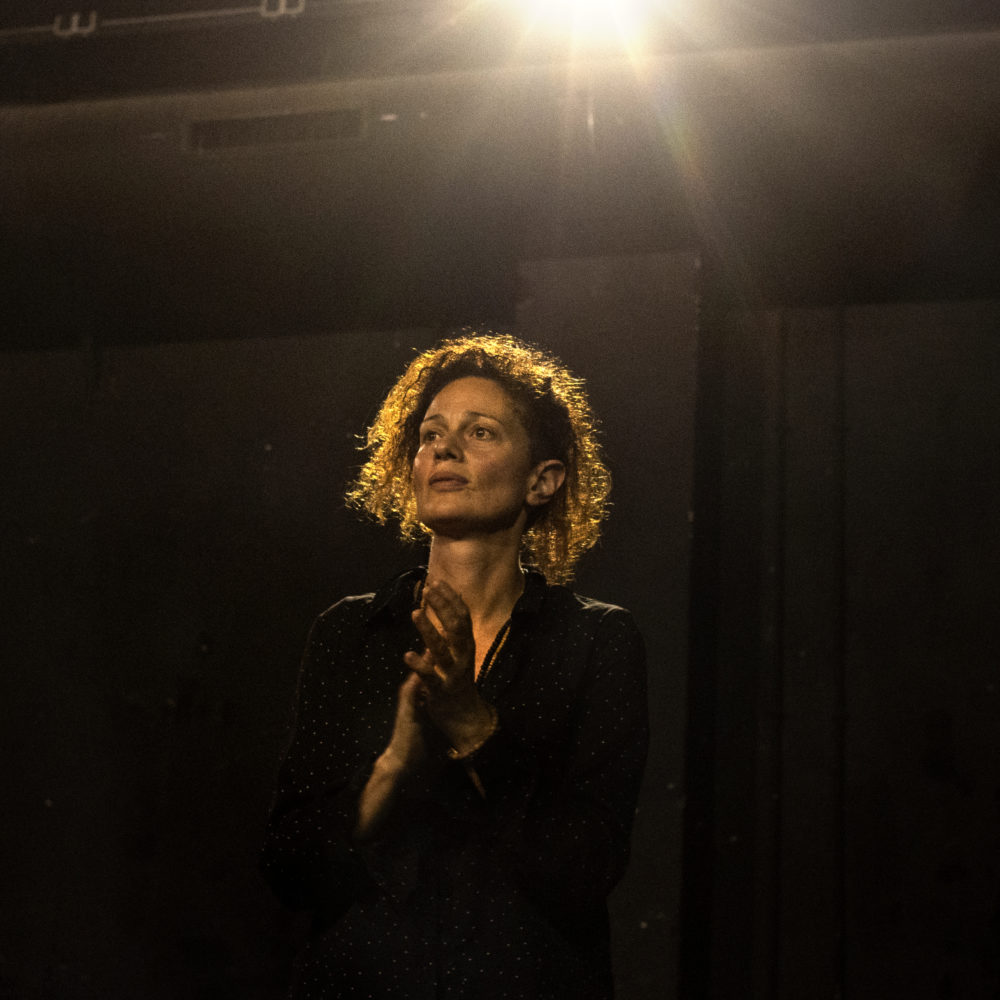)
